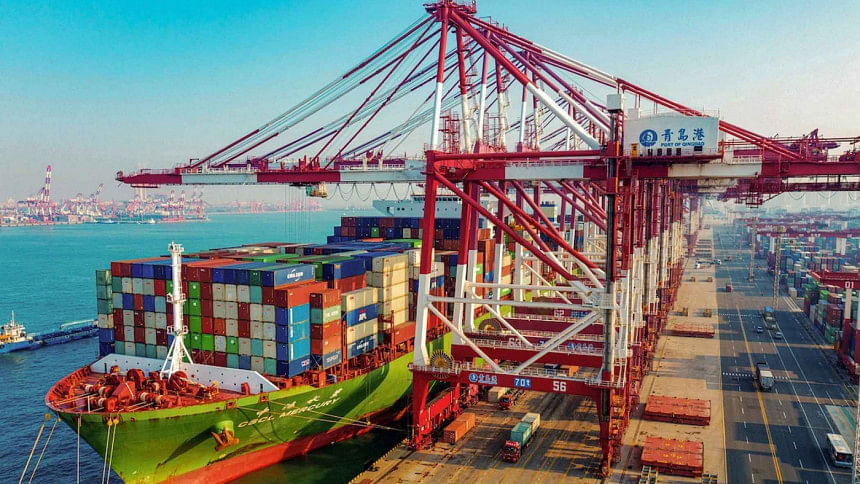How Bangladesh can benefit from China’s economic recovery

As the nation holds its breath in anticipation of a potential second wave of Covid-19, five countries including Bangladesh have decided to strengthen sharing of information and coordination of policies and actions to cope with its probable impacts. China, Nepal, Pakistan and Sri Lanka are the other countries that are part of this initiative which aims to step up cooperation in testing, diagnostics, treatment and medicine. The five countries also agreed on the importance of harmonising economic and social development, and on advancing Belt and Road cooperation to boost post-Covid-19 economic recovery.
To a great extent, China is the key here. According to a recent report called FDI Intelligence, Bangladesh is among the top five economies that are recovering faster as a result of the Chinese economy, which is expected to return to its pre-Covid level soon. "China's resilience is... shoring up growth in the region, particularly in Vietnam and Bangladesh," the report said.
In the third quarter of this year, China's major economic indicators entered positive territory, indicating that the country is at the forefront of economic recovery among the world's major economies. In the first three quarters, China posted its best economic performance of the year, rendering a 0.7 percent year-on-year expansion for the first nine months, becoming the first major economy to return to growth following the economic fallout of Covid-19.
China's industrial output rose 5.8 percent and retail sales reported their first quarterly expansion, up 0.9 percent year-on-year in the third quarter—marking a drastic rebound from a 6.8 percent contraction in the first quarter after the virus hit. It was in the second quarter that the economy started to show signs of a resurgence, notching a 3.2 percent growth, before recording a 4.9 percent year-on-year growth in the third quarter. Despite serious concerns towards the beginning of the year, the country's overall trade in the first three quarters outperformed expectations with exports adding up to USD 1.89 trillion and imports reaching USD 1.54 trillion.
Even amidst the crisis, economic and trade cooperation between Bangladesh and China have continued to deepen. "Chinese companies have implemented several major infrastructure projects in Bangladesh's transportation, energy and electricity, telecommunications and other fields, making positive contributions to the economic and social development of the two countries," according to China's Ambassador to Bangladesh Li Jiming. Ambassador Jiming, in an interview with Global Times in late October, was quick to highlight that the economies of Bangladesh and China were highly complementary to each other. And in terms of large scale investment, the undertaking of the Padma Bridge Rail Link project with Chinese funds, costing around USD 3.14 billion, was a mentionable success—as since going into service on July 3, 2018 it has created more "than 5,000 direct jobs and tens of thousands of indirect jobs for local residents as well as bringing subcontracting business to more than 100 local companies."
But according to economist Rehman Sobhan, when talking about Chinese investment, "we shouldn't just talk about [infrastructure] investment as most of it are coming in the form of aid or for specific projects and those investments are ad-hoc in nature." Professor Sobhan believes that the scope of China's investment has to be broadened to go "beyond infrastructure" alone. He urged Bangladesh Bank and the finance ministry to "consider Chinese interest in introducing RMB as a trading currency."
The reason for this is simple. China is Bangladesh's largest trading partner with annual bilateral commerce between the two countries totalling over USD 12.13 billion. In the fiscal year 2019-20, Bangladesh imported goods worth over USD 11.53 billion from China, while exporting goods of over USD 600 million only. That is not good enough—as it created a trade gap of nearly USD 11 billion in the last fiscal year. According to one high official of the commerce ministry, "Bangladesh has been suffering from a continuous trade imbalance [with China] over the years." And thus the commerce ministry has suggested requesting China to relax the APTA Rules of Origin and Rules of Origin of Zero Tariff Treatment for Bangladesh in the form of 25 percent value addition instead of 40 percent in processed products.
China already granted duty-free and quota-free access to 8,549 Bangladeshi products, which may help address this enormous trade imbalance over time. However, since the benefit—given by China to Bangladesh as a least developed country under the World Trade Organisation's provision—only came into effect from July 1, 2020, we are yet to see its full impact. Moreover, when Bangladesh graduates to a developing country status (slated for 2024), these benefits may get withdrawn. Which means Bangladesh needs to find other ways to mitigate the imbalance. The good news is that, as China is taking steady steps to further open up its domestic market and expand imports, it is estimated that China's total imports could go as high as USD 22 trillion in the coming decade. And so, it would be wise for Bangladesh to try and carve out a good piece of that for itself.
On the flipside, as more and more companies seek to move their manufacturing base away from China in view of the Covid-19 pandemic and the changing nature of its economy, Bangladesh should try and lure them towards its direction. At the recent Economic Reporters Forum, Japan External Trade Organisation's country representative Yuji Ando said that "although more Japanese companies are expected to come to Bangladesh every year, the investment environment needs to be further congenial." Citing one annual study, he said that 70 percent of Japanese companies in Bangladesh were keen on expanding their businesses, which is the highest among other countries. And it seems that the government is quite aware of that. According to reports, the government is looking to simplify its foreign direct investment policy and corporate tax system with the aim of increasing foreign investment in Bangladesh. And China, as is well known, is an excellent model on how to effectively do that—to the point where it can now focus much more on domestic investment.
Eresh Omar Jamal is a member of the editorial team at The Daily Star.
His Twitter handle is: @EreshOmarJamal

 For all latest news, follow The Daily Star's Google News channel.
For all latest news, follow The Daily Star's Google News channel. 



Comments